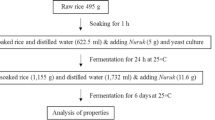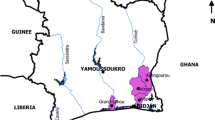Abstract
The aim of this work was to characterize the indigenous wine Saccharomyces cerevisiae diversity within the Argentinean Patagonia. Two cellars with particular enological practices located in different winegrowing areas were selected and 112 indigenous S. cerevisiae isolates were obtained from spontaneous red wine fermentations carried out in them. Thirty-five and 19 patterns were distinguished among the total indigenous isolates using mtDNA-RFLP and killer biotype analysis, respectively. The combination of both typing techniques rendered a higher variability with 42 different patterns, i.e. 42 strains, evidencing a great diversity in S. cerevisiae populations associated with spontaneous red wine fermentations in Northwestern Patagonia. The analysis of the relatedness among strains using Principal Coordinates Analysis from combined data allowed the clustering of the strains into two populations significantly related to their origin fermentations. The combined use of the mtDNA-RFLP analysis together with the killer biotype method proved to be a powerful tool in the fingerprinting of the enological S. cerevisiae strains.
Similar content being viewed by others
References
Baleiras Couto M., Eijsma B., Hofstra H., Huis J., Vossen J. (1996). Evaluation of molecular typing techniques to assign genetic diversity among Saccharomyces cerevisiae strains. Appl. Environ. Microbiol. 62:41–46
Buzzini P., Martini A. (2000). Utilization of differential killer toxin sensitivity patterns for fingerprinting and clustering yeast strains belonging to different genera. Syst. Appl. Microbiol. 23:450–457
Constantí M., Poblet M., Arola L., Mas A., Guillamón J.M. (1997). Analysis of yeast populations during alcoholic fermentation in a newly established winery. Am. J. Enol. Vitic. 48:339–344
Epifanio S.I., Gutiérrez A.R., Santamaría M.P., López R. (1999). The influence of enological practices on the selection of wild yeast strains in spontaneous fermentation. Am. J. Enol. Vitic. 50:219–224
Fernández-Espinar M., Esteve-Zarzoso B., Querol A., Barrio E. (2000). RFLP analysis of the ribosomal internal transcribed spacers and the 5.8S rRNA gene region of the genus Saccharomyces: a fast method for species identification and the differentiation of flor yeasts. Antonie van Leeuwenhoeck 78:87–97
Frezier V., Dubourdieu D. (1992). Ecology of yeast strain Saccharomyces cerevisiae during spontaneous fermentation in a Bordeaux winery. Am. J. Enol. Vitic. 43:375–380
Ganter P.F., Starmer W.T., (1992). Killer factor as a mechanism of interference competition in yeasts associated with cacti. Ecology 73:54–67
Guillamón J.M., Barrio E., Querol A. (1996). Characterization of wine yeast strains of the Saccharomyces genus on the basis of molecular markers: relationships between genetic distance and geographic or ecological origin. Syst. Appl. Microbiol. 19:122–132
Gutiérrez A.R., López R., Santamaría P., Sevilla M.J. (2000). Characterization of oenological strains of Saccharomyces cerevisiae using cellular fatty acid and mtDNA restriction polymorphism analysis. Sciences des Aliments 20:321–330
Kurtzmann C.P., Fell J.W., (1998). The yeast, a taxonomic study. Elsevier Science Publications, Amsterdam, Netherlands
Le Guillou B. (2000). Río Negro. De la vigne dans des oasis de la Patagonie argentine. La Vigne 116:112–113
Lopes C.A. 2004. Biotecnología de vinos: selección de una cepa de levadura indígena destinada a la producción de un starter de fermentación vínica para ser usado en denominación de origen. PhD Thesis. Universidad Nacional del Comahue Argentina.
Lopes C.A., van Broock M., Querol A., Caballero A. (2002). Saccharomyces cerevisiae wine yeast populations in a cold region in Argentinean Patagonia A study at different fermentation scales. J. Appl. Microbiol. 93:608–615
Martinez C., Gac S., Lavin A., Ganga M. (2004). Genomic characterization of Saccharomyces cerevisiae strains isolated from wine-producing areas in South America. J. Appl. Microbiol. 96:1161–1168
Pérez M., Gallego F., Hidalgo P. (2001). Evaluation of molecular techniques for the genetic characterization of Saccharomyces cerevisiae strains. FEMS Microbiol. Lett. 205:375–378
Pretorius I.S. (2000). Tailoring wine yeast for the new millennium: novel approaches to the ancient art of winemaking. Yeast 16:675–729
Querol A., Ramón D. (1996). The application of molecular techniques in wine microbiology. Trends Food Sci. Technol. 57:183–185
Querol A., Barrio E., Huerta T., Ramón D. (1992a). Strain for use as dry yeast in fermentation of Alicante wines: selection and DNA patterns. J. Food Sci. 57:183–185
Querol A., Barrio E., Ramón D. (1992b). A comparative study of different methods of yeast strain characterization. Syst. Appl. Microbiol. 15:439–446
Querol A., Barrio E., Ramón D. (1994). Population dynamics of natural Saccharomyces strains during wine fermentation. Int. J. Food Microbiol. 21:315–323
Rohlf F.J. (2002). NTSYSpc: Numerical Taxonomy System 2.1. Exeter Publishing Ltd., Setauket, NY
Sabate J., Cano J., Querol A., Guillamón J.M. (1998). Diversity of Saccharomyces strains in wine fermentations: analysis for two consecutive years. Lett. Appl. Microbiol. 26:452–455
Sangorrín M., Zajonskovsky I., van Broock M. and Caballero A. (2002). The use of killer biotyping in an old patagonian winery yeast ecological survey. World J. Microbiol. Biotechnol. 18:115–120
Sangorrín M.P., Zajonskovsky I.E., Lopes C.A., Rodríguez M.E., Giraudo de van Broock M.R. and Caballero A.C. (2001). Killer behaviour in wild wine yeasts associated with Merlot and Malbec type musts spontaneously fermented from Northwestern Patagonia Argentina. J. Basic Microbiol. 41:105–113
Schuller D., Alves H., Dequin S. and Casal M. (2005). Ecological survey of Saccharomyces cerevisiae strains from vineyards in the Vinho Verde Region of portugal. FEMS Microbiol. Ecol. 51:167–177
Schuller D., Valero E., Dequin S. and Casal M. (2004). Survey of molecular methods for the typing of wine yeast strains. FEMS Microbiol. Lett. 231:19–26
Schütz M. and Gafner J. (1993). Analysis of yeast diversity during spontaneous and induced alcoholic fermentations. J. Appl. Bacteriol. 75:551–558
Soden A., Francis I.L., Gockowiak H., Lee T.H. and Henschke P.A. 1998. The use of non-Saccharomyces yeasts in winemaking. In: Blair R.J., Sas A.N., Hayes P.F. and Hoj P.B. (eds), Proceedings Tenth Australian Wine Industry Technical Conference. Sydney: New South Wales, Australia, pp. 166–171
Sokal R.R., Michener C.D. (1958). A statistical method for evaluating systematic relationships. University of Kansas Scific Bulletin 38:1409–1438
Torija M.J., Rozés N., Montse P., Guillamón J.M., Mas A. (2002). Effects of fermentation temperature on the strain population of Saccharomyces cerevisiae. Int. J. Food Microbiol. 80:47–53
Vaughan-Martini A., Cardinali G., Martini A. (1996). Differential killer sensitivity as a tool for fingerprinting wine-yeast strains of S. cerevisiae. J. Ind. Microbiol. 17:124–127
Versavaud A., Courcoux P., Roulland C., Dulau L., Hallet J. (1995). Genetic diversity and geographical distribution of wild Saccharomyces cerevisiae strains from the wine-producing area of Charentes, France. Appl. Environ. Microbiol. 61:3521–3529
Author information
Authors and Affiliations
Corresponding author
Rights and permissions
About this article
Cite this article
Lopes, C.A., Lavalle, T.L., Querol, A. et al. Combined use of killer biotype and mtDNA-RFLP patterns in a Patagonian wine Saccharomyces cerevisiae diversity study. Antonie Van Leeuwenhoek 89, 147–156 (2006). https://doi.org/10.1007/s10482-005-9017-y
Received:
Accepted:
Published:
Issue Date:
DOI: https://doi.org/10.1007/s10482-005-9017-y




